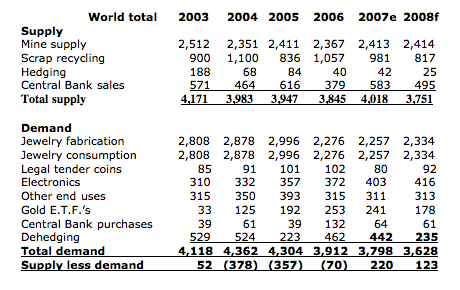Gold Forecaster
- Global Watch
Gold - What's driving it
higher?
Julian D.W.
Phillips
Gold Forecaster snippet
Dec 21, 2007
As we approach the end of 2007
and a time when gold looks poised to move through its record
high, and a time when global financial volatility and uncertainty
have never been higher, it is time to look at what's driving
the gold market now and what lies ahead in 2008.
There is no doubt that during
2007 the gold market has evolved from one suffering persistent
undermining attack by global monetary authorities over the last
25 years [through sales and accelerated supply] began to fade
noticeably, as the credibility of its replacement, the U.S. $
began to decay visibly, to one that garnered a new respect, if
only amongst both private and fund investors. And by funds, we
are not referring to the short-term speculators but to long-term
holders, primarily of gold Exchange Traded Fund shares. It is
primarily Investor demand that will drive the demand for gold
in 2008 because of the enviable position it holds, which we describe
below.
Add to the above the meteoric
rise of the oil price and we saw gold beginning to act as a counter
for dropping confidence in the monetary system attracting more
investment demand. Such decay was amply described by and ex-Treasury
Official in an essay, in which he pre-ambled as follows.
More than a confidence
crisis!
"Many $ holders,
including central banks and sovereign wealth funds as well as
private investors, clearly want to diversify into other currencies.
Since foreign $ holdings total at least $20,000 billion, even
a modest realization of these desires could produce a free fall
of the U.S. currency and huge disruptions to markets and the
world economy. Fears of such an outcome have risen sharply in
both official circles and the markets.
However, none of the countries
into whose currencies the diversification would take place want
to receive these inflows. The Eurozone, the UK, Canada, and Australia
among others believe that their exchange rates are already substantially
overvalued. But China and most of the other Asian countries continue
to intervene heavily to keep their currencies from rising significantly.
Hence, further large shifts out of the $ could indeed push the
floating currencies far above their equilibrium levels, generating
new imbalances and a possibly severe slowdown in global growth."
This is the atmosphere that
has driven investment demand for gold and in turn the gold price.
We expect that in the year ahead, this climate will deteriorate
substantially driving investment demand to new record levels.
But let's be clear about this, we are not talking of a simple
rising of investment demand, we believe we will see a
large acceleration in that demand taking it well through
four figures in tonnage terms as well as in price terms.
At each stage of its growth
it will attract bigger players as the liquidity of these shares
gives comfort to the larger players. Indeed, the total holdings
of such funds are already equal to the holding of the top echelon
of Central Bank holdings, even above that of China having moved
into the equivalent of seventh place and likely to move into
sixth place next year ahead of Switzerland.
We have said in the past that
a level of 3,000 tonnes holdings by the gold E.T.F.s is possible
and will attract the biggest players. At the time many thought
it was far fetched, but as total holdings by such funds [including
the Canadian equivalent] crosses the 860 tonne level, such forecasts
are proving more than credible.
Bear in mind that the huge
financial power of the Mutual / Pension etc funds is now able
to invest almost directly in gold [via these shares]. This buying
power was just not present before the creation of the gold E.T.F.s.
Each day this demand grows as new gold Investors come into this
market and there is a massive amount out there still to come
in. Funds before the Exchange Traded Fund concept were just not
permitted to hold gold. The nearest they could come to that was
to own gold shares with all their inherent risks. Now that investing
power is unleashed needing only the education that gold in share
form is now available to them. It is this power that is becoming
the main driving force behind the rise in gold.
As you can see in the Table
below [thanks to Fortis Bank] investment demand just has to exceed
123 tonnes for the year [last week saw 17 tonnes added to the
funds] for the gold market to be in deficit.
We want you to note well supply
less demand and the change in dehedging expected.

The only danger in the next
two years to the power of the gold E.T.F.s is that the demand
engendered by dehedging will slow down to stop in the next year
and more. In 2007 it will be 400 tonnes, but in 2008 it could
drop as low as 210 tonnes or thereabouts.
The only counter to this demand,
apart from investment demand is the strong chance that Central
Banks gold sales will pull back in the face of the much lower
level of announced sales. If no new announcements are made then
these sales if evened out over the remaining years of the agreement
could drop to 250 tonnes, down from nearly 500 tonnes, in the
last year of the agreement.
So what's driving gold?
Primarily, investment demand and dropping supply.
Please subscribe to GoldForecaster
for the entire report.
Dec 14, 2007
-Julian
D.W. Phillips
email: gold-authenticmoney@iafrica.com
321gold Ltd

|